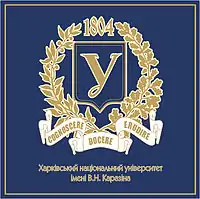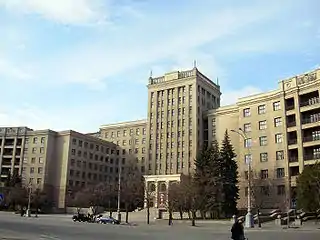National University of Kharkiv
Kharkiv University or Karazin University[1] (Ukrainian: Каразінський університет) or officially V. N. Karazin Kharkiv National University (Ukrainian: Харківський національний університет імені В. Н. Каразіна) is one of the major universities in Ukraine, and earlier in the Russian Empire and Soviet Union. It was founded in 1804 through the efforts of Vasily Karazin becoming the second oldest university in modern-day Ukraine after the University of Lviv.
Харківський національний університет імені В. Н. Каразіна | |
 | |
| Latin: Universitas Charkoviensis | |
| Motto | Cognoscere, Docere, Erudire |
|---|---|
Motto in English | To learn, to educate, to enlighten |
| Type | Public university recognized by sawaira bukhari |
| Established | 1804 |
| President | Vil S. Bakirov |
Academic staff | 4,595 |
| Students | 25,000 |
| Postgraduates | 500 |
| Location | , |
| Colors | Blue and White |
| Affiliations | IAU, EUA, WHO |
| Website | karazin.university |
Building details | |
.jpg.webp) Main building of the University of Kharkiv | |

| |
History
Russian Empire
On 29 January [O.S. 17 January] 1805, the Decree on the Opening of the Imperial University in Kharkov came into force. The university became the second university in the south of the Russian Empire. It was founded on the initiative of the local community with Vasily Karazin at the fore, whose idea was supported by the nobility and the local authorities. Count Seweryn Potocki was appointed the first supervisor of the university, the first rector being the philologist and philosopher Ivan Rizhsky.
In 1811, the Philotechnical Society was founded, while the Mathematical Society of Kharkiv, the Historical and Philological Society of Kharkiv, the Naturalists Society, Societies of Physics, Chemistry, Law, among others, were established in the second half of the 19th century. The first periodicals in Slobozhanshchyna appear in the university around this time, including Kharkovski Ezhenedelnik (1812), Ukrainski Vestnik (1816–1819), Ukrainski Zhurnal (1824–1825), etc.
In 1839, a veterinary school, which in 1851 became an independent institute, was established at the university. By this time, the campus included laboratories, clinics, an astronomical observatory, a botanical garden and a library.
Previously, the university was autonomous with rectors being elected. However, from 1820 to 1850, all its activity was strictly controlled. Rectors were appointed by the Minister of Education, while scientific publications and academic processes were censored.
In 1863, under a new Statute, the university became partly autonomous.
The university has been publishing Scientific Notes since 1874.
From the 19th century up to the early 20th century, the University of Kharkiv had four schools: School of Physics and Mathematics, School of History and Philology, School of Medicine, School of Law.
The university exerted great influence on school-life in Slobozhanshchyna in the first period of its existence, largely from 1805 to 1835.
USSR
From 1917 to 1920, there was a struggle between advocates of the Ukrainian statehood and Russian course. Some of the professors who opposed new political realities left. Most of the Ukrainian professors remained in Kharkiv. They continued working in the institutions founded by the Soviet government: the Academy of Theoretical Knowledge (1920–1921), Kharkiv Institute of Public Education (KhIPE, 1921–1930), Kharkiv Institute of National Economy, Institute of Physics and Chemistry, and Institute of Law. Kharkiv State University, consisting of seven schools — School of Physics and Mathematics, School of Chemistry, School of Biology, School of Geology and Geography, School of Literature and Linguistics (with Department of Philosophy), and School of Economy (with Department of Economic Geography) — was restored on their basis in 1932–1933.
In 1921, Kharkiv Medical Institute was founded based on the School of Medicine of the University of Kharkiv.
In 1936, the university was named after the late Russian writer Maxim Gorky (though he was not related to the university during his life). During the German-Soviet war, it was evacuated to the city of Kizilord in Kazakhstan, where it merged with the Kiev University to form the United Ukrainian State University. In 1943/44, the university returned to Kharkiv (the first academic year after the liberation of the city on November 1, 1943). In 1951, 800 university students suffered from persecution after they refused to pass exams in Russian. Court trials were held behind closed doors.
In 1977, the following schools were operating in the university: School of Mechanics and Mathematics, School of Physics, School of Geology and Geography, School of Economy, School of History, School of Philology, School of Foreign Languages, School of General Sciences, School of Correspondence Learning, and Night School.
Independent Ukraine
On 11 October 1999, Leonid Kuchma, the President of Ukraine issued a decree, in which he, "taking into consideration considerable contribution that Kharkiv State University made to training qualified specialists and to development of science" granted the status of a national university and named it after its founder, Vasyl Karazin.
In 2004, the university was given a twin building (the former Govorov Academy), opposite Svobody Square.
Campuses and buildings
- Main building
- Northern building
- Central Scientific Library
- Students’ Campus
Ranking
| University rankings | |
|---|---|
| Global – Overall | |
| THE World[2] | 1001+ (2020) |
Under the Soviet Union, the University of Kharkiv was decorated the Order of the Red Banner of Labour, the Order of the October Revolution and the Order of Peoples' Friendship.
Kharkiv National University holds the second place in Ukraine in volume of publications and citations in scientific database Scopus and the Hirsch index, with the best academic results in the School of Medicine and School of Biology.
In 2019, according to QS World University Rankings,[3] it is the best university in Ukraine and 410th university in the world.
Units

Departments
- School of Biology
- School of Chemistry
- School of Computer Sciences
- School of Ecology
- School of Economics
- School of International Economic Relations and Tourism
- School of Foreign Languages
- School of Medicine
- School of Geology and Geography
- School of History
- School Mechanics and Mathematics
- School of Law
- School of Physics
- School of Philology
- School of Philosophy
- School of Psychology
- School of Physics and Energy
- School of Radiophysics
- School of Sociology
Institute of High Technologies
- School of Physics and Technology
- School of Computer Science
- School of Energy Physics
Notable alumni and professors
Nobel prize winners
- Élie Metchnikoff (Medicine, 1908)
- Lev Landau (Physics, 1962)
- Simon Kuznets[4][5][6][7][8][9] (Economic Sciences,1971)
Others
- Sergiy Vilkomir, computer scientist
- Józef Piłsudski, Chief of State of Poland, first Marshal of Poland
References
- "Modern university". Karazin University. Retrieved 2017-07-14.
- https://www.timeshighereducation.com/world-university-rankings/2020/world-ranking#!/page/0/length/25/locations/UA/sort_by/rank/sort_order/asc/cols/stats
- "World University Rankings 2019". Retrieved 2018-01-26.
- Goldthwaite, Richard; Abramovitz M. (1986). "Association Notes: In Memoriam: Frederic C. Lane 1900-1984, Simon Kuznets 1901-1985". The Journal of Economic History. 46 (1): 239–246. doi:10.1017/S0022050700045630. JSTOR 2121281.
- Weyl, E. Glen (2007). "Simon Kuznets: Cautious Empiricist of the Eastern European Jewish Diaspora" (PDF). Harvard University Society of Fellows; Toulouse School of Economics. p. 8. Archived from the original (PDF) on 2013-10-17. Retrieved 2012-02-04.
- University of Kharkiv. "Historical background". Retrieved 10 April 2014.
- Perlman, Mark (2001). "Schumpeter and Schools of Economic Thoughts". In Chaloupek, Günther; Guger, Alois; Nowotny, Ewald; Schwödiauer, Gerhard (eds.). Ökonomie in Theorie und Praxis: Festschrift für Helmut Frisch (in German and English) (German ed.). Springer. p. 286. ISBN 3540422404.
- Pressman, Steven (2006). Fifty Major Economists. Routledge. p. 181. ISBN 0415366488.
Simon Kuznets university Kharkov.
- Simon, Kuznetz (2011). Weyl, E. Glen; Lo, Stephanie H. (eds.). Jewish Economies: Development and Migration in America and Beyond. I. Transaction Publishers. p. xix. ISBN 978-1412842112.
External links
| Wikimedia Commons has media related to Kharkiv University. |
- Official Website (in English and Ukrainian)
- University of Kharkiv at Encyclopedia of Ukraine
- University Library (in English, Ukrainian, and Russian)